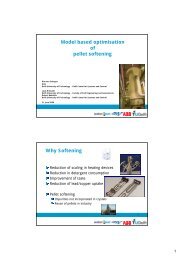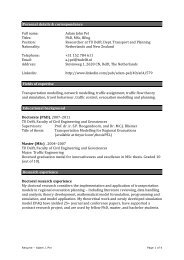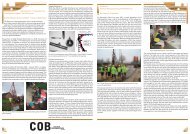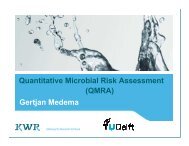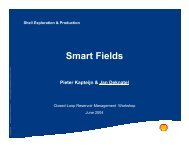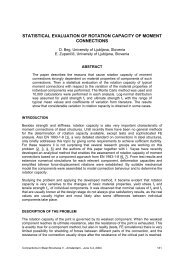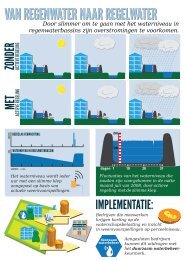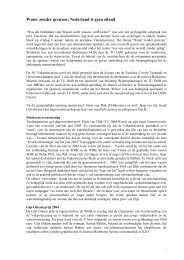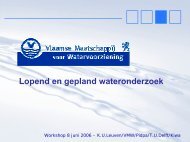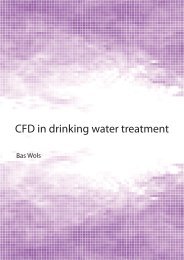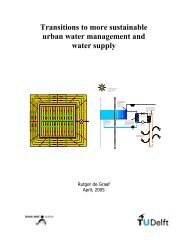Discolouration in drinking water systems - TU Delft
Discolouration in drinking water systems - TU Delft
Discolouration in drinking water systems - TU Delft
You also want an ePaper? Increase the reach of your titles
YUMPU automatically turns print PDFs into web optimized ePapers that Google loves.
the order of 2 can be expected, mak<strong>in</strong>g it difficult to draw conclusions from these<br />
measurements. The measurements are reported here because the methodology can still be<br />
applied if the filter itself is also analysed for suspended solids. In this case, however, that<br />
could not be done because the filters were already too tampered with and partly destroyed.<br />
3.5 Discussion<br />
Not surpris<strong>in</strong>gly all measurements show that the sediment load at the Research Area was<br />
significantly less than at the Reference Area. Theoretically the sediment load to the Research<br />
Area should be negligible, but <strong>in</strong> practise it turns out that even <strong>in</strong> the outflow of the UFreservoir<br />
some calculated particle volume was present. These particles were probably picked<br />
up <strong>in</strong> the UF-reservoir. Though the reservoir had been cleaned before be<strong>in</strong>g taken <strong>in</strong>to service,<br />
it obviously conta<strong>in</strong>ed some particles that settled <strong>in</strong> the first pipe of the network. The<br />
Hemoflow measurement that had been done on the outflow of the UF-<strong>in</strong>stallation shows that<br />
the actual amount of TSS was virtually negligible. The total amount of loose deposits<br />
removed from the Research Area at the end of the measur<strong>in</strong>g period was less than 8% of the<br />
amount removed from the Reference Area. The ma<strong>in</strong> difference between the two <strong>systems</strong> was<br />
the particle volume <strong>in</strong> the <strong>water</strong> that was supplied, s<strong>in</strong>ce materials that were used and the<br />
diameters that were applied are the same. The UF-treatment only removed the TSS from the<br />
<strong>water</strong>, but left other components as AOC and other soluble substances unchanged. The<br />
chemical properties of the <strong>water</strong> were identical.<br />
The average VSS level of the samples flushed from the Research area was 60,6%, while the<br />
average VSS level of the samples flushed from the Reference Area was 42,5%. In the<br />
Research Area 89,9 mg/m of loose particles were flushed out and <strong>in</strong> the Reference Area<br />
1071,2 mg/m. Those percentages applied to the deposits would <strong>in</strong>dicate that the<br />
correspond<strong>in</strong>g organics are 54,0 mg/m and 450,0 mg/m respectively.<br />
In the Reference Area 27% of the <strong>in</strong>com<strong>in</strong>g TSS was VSS (Table 3-15). If this percentage is<br />
applied to the sediments found that would account for 121 mg/m of the total 450 mg/m found<br />
<strong>in</strong> the Reference Area. If the VSS is considered to be the product of biological regrowth then<br />
the net growth <strong>in</strong> the Reference Area results <strong>in</strong> 329 mg/m organic matter and <strong>in</strong> the Research<br />
Area <strong>in</strong> 54,0 mg/m organic matter, a significant difference of a factor of more than 6. The UFmembrane<br />
treatment doesn’t take out the AOC, as this is soluble. Other biological properties<br />
of the <strong>water</strong> such as colony counts are not considered <strong>in</strong> this study, but with these results it is<br />
plausible that the amount of particles <strong>in</strong> the <strong>water</strong> and those accumulated <strong>in</strong> the network<br />
promotes biological regrowth, because they offer a service to grow on (van der Kooij, 2000;<br />
Huck and Gagnon, 2004).<br />
In the Research Area a sediment amount has been removed that is equal to a sediment rate of<br />
89,9 mg/m while <strong>in</strong> the Reference Area a sediment rate of 1071,2 mg/m was found. (Carriere<br />
et al., 2005) report sediment rates vary<strong>in</strong>g from 30 to 24500 mg/m and (Barbeau et al., 2005)<br />
gives values of 260 to 410 mg/m. These sediment rates, however, were based on samples<br />
taken under different and non-uniform circumstances that can lead to both over- and<br />
underestimat<strong>in</strong>g of the ‘real’ sediment rate.<br />
In earlier research sediment rates <strong>in</strong> small diameter pipes are found <strong>in</strong> the order of 3,9 to 247,3<br />
mg/m. In a cast iron network that is supplied with <strong>water</strong> treated with slow sand filtration as<br />
the f<strong>in</strong>ish<strong>in</strong>g treatment step, sediment rates were found rang<strong>in</strong>g from 9,1 to 63,3 mg/m<br />
(Vreeburg et al., 2007).<br />
The Surf-90% and Surf+90% values of the particle volume of the Reference and Research<br />
Areas show that the major part of the particle load<strong>in</strong>g was done <strong>in</strong> a relatively short time. The<br />
actual particle load to the system is also dependent on the volume flow. In the Reference Area<br />
Particle free <strong>water</strong> - 60 -



